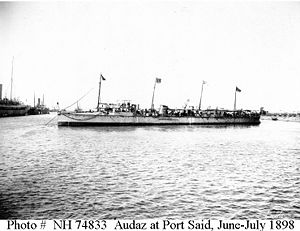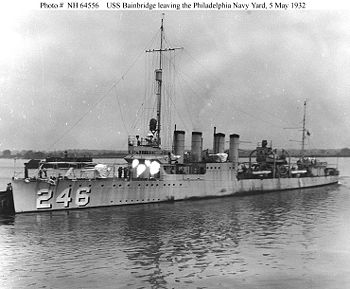CZ:Featured article/Current
A destroyer is a type of warship, the nature of which has evolved since it first came into use, roughly at the beginning of the twentieth century. Several other warship designations have, at different times and in different navies, overlapped the "destroyer" role. Most common among these roles are cruiser and ocean escort. Another type of vessel, whose nomenclature is the root of "destroyer", has been called "torpedo boat" and exists in new forms generically called fast attack craft.
Initial usage
When the modern self-propelled torpedo was invented, in 1866, by Robert Whitehead, it was initially added to conventional warships, but navies soon realized that a small, fast craft, with a main battery of torpedoes, could threaten much larger warships such as battleships. The battleship of the early 20th century was the largest, most heavily armed, and most heavily protected warship type, but relatively slow and not extremely maneuverable. Torpedo boats were generally not capable of long-range steaming or being seaworthy in the "blue water" deep ocean; they were coastal craft.
When battleships and other large ships, possibly escorting unarmed cargo and troop transports, needed to approach a hostile shore, they needed to deal with the torpedo boat threat. A partial solution was adding a secondary gun battery of smaller caliber, faster firing rate, and faster aiming than the main guns intended to sink other battleships, but the secondary battery still let the torpedo boats come too close.
A new type of vessel, called the "torpedo boat destroyer", was developed as an escort to major warships, and possibly merchant vessels threatened by torpedo boats. In the words of a requirement restated a century later, "Self-deployability (blue water endurance) is needed to allow the platforms to get to the contested area without the need for valuable and scarce open ocean transport or the support of an ever-present mothership." Such vessels still had to be small, fast, and maneuverable enough to pursue and destroy torpedo boats. Early approaches to increasing range and self-deployability included the use of sails in addition to steam, on the Spanish torpedo boat destroyer Audaz, in service between 1897 and 1927.
It soon became obvious that the torpedo boat destroyer was a useful vessel for a wide range of applications, such as convoy escort, so the specialized designation became the simple "destroyer". Ironically, while the first destroyers were armed only with quick-firing guns, usually of several calibers from medium to light, navies started equipping destroyers with torpedoes, as the weapon of choice if they did need to confront battleships. For simplicity, the category of "cruiser" is not being included in this immediate discussion; simply assume they were vessels of intermediate characteristics between battleships and destroyers.
The new destroyers would usually make torpedo attacks in groups. Such groups would often be built around a light cruiser or a ship called a destroyer leader; both types were more survivable and more heavily armed than destroyers, which better fitted them to lead the attack unit. Early destroyers were intended to be small and inexpensive, with numbers of hulls being more important than individual ship capability.
First World War, and a new torpedo threat
The pure torpedo boat was becoming less popular around the start of the First World War, although variants would keep returning. Torpedoes, however, were still a real threat, but from submarines rather than surface vessels.
Technology for finding submerged submarines lagged the introduction of the undersea weapons, and was quite primitive and short-ranged. In general, the first antisubmarine sensors were passive listening devices, called "hydrophones". Putting hydrophones on many destroyers allowed an antisubmarine screen to be formed around the "high-value assets", the vessels the submarines had as primary targets.
Once a submerged submarine was located, location being a very loose term at the time, the destroyer needed some way to attack it. Clearly, guns that could blow a surface torpedo boat out of the water were not the answer, since they cannot shoot at underwater targets. The first antisubmarine weapons were depth charges, or containers of explosives that would be dropped, from the surface, over the location of a suspected submarine, and would detonate when they reached a preset depth. The submarine's depth was even harder to determine than its range and bearing from the destroyer; it was estimated based on the strength of the sound, knowledge of the bottom depth and water characteristics, and a seaman's judgment. Since the submarine's position was poorly defined, large explosive charges were needed to have a chance of damage with other than a lucky direct hit.
By 1918, however, an active sound-based technique, code-named ASDIC for an apparently nonexistent "Allied Submarine Detection Investigation Committee" was mounted on several British and U.S. destroyers. It came too late for combat use in the First World War, but development actively continued. The more common term became sonar, for "sound detection and ranging". In modern intelligence terminology, active and passive sound-based systems were the acoustic MASINT or acoustic intelligence of geophysical measurement and signal intelligence.

